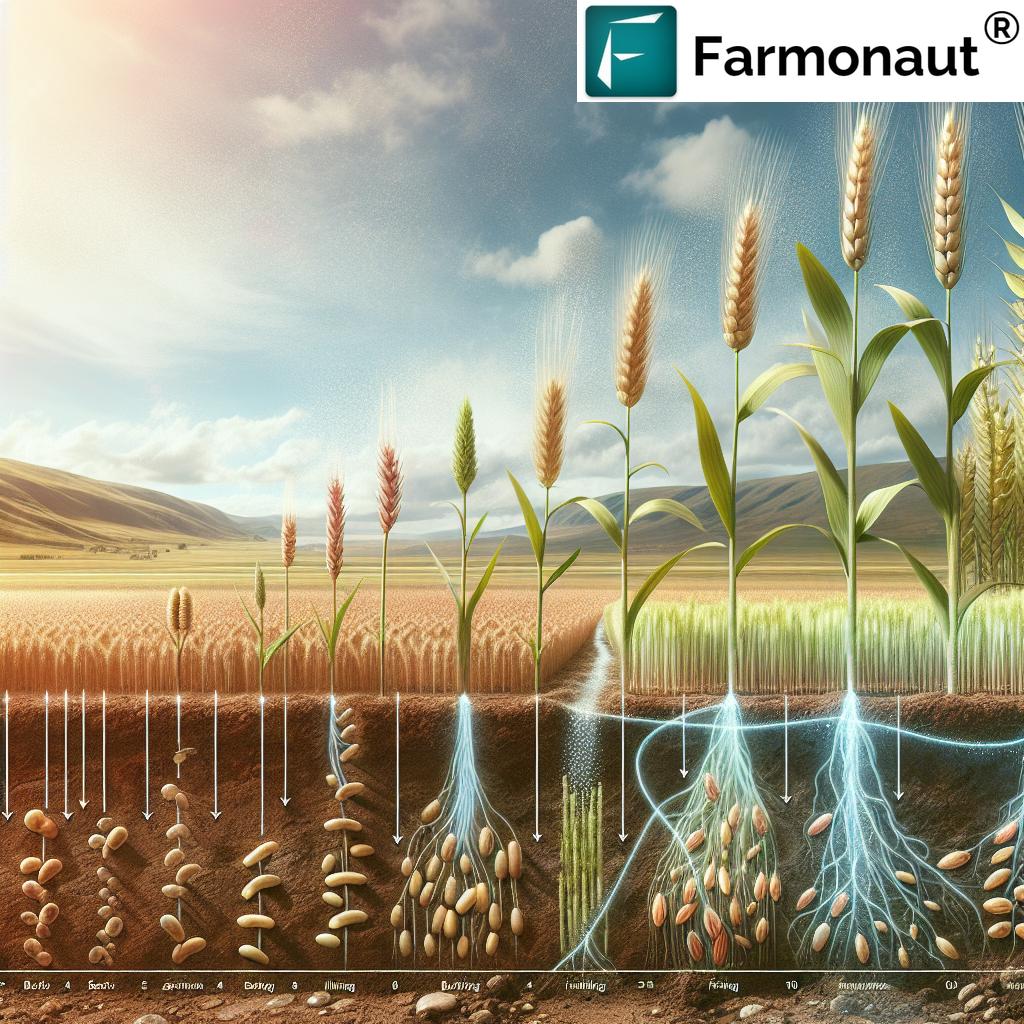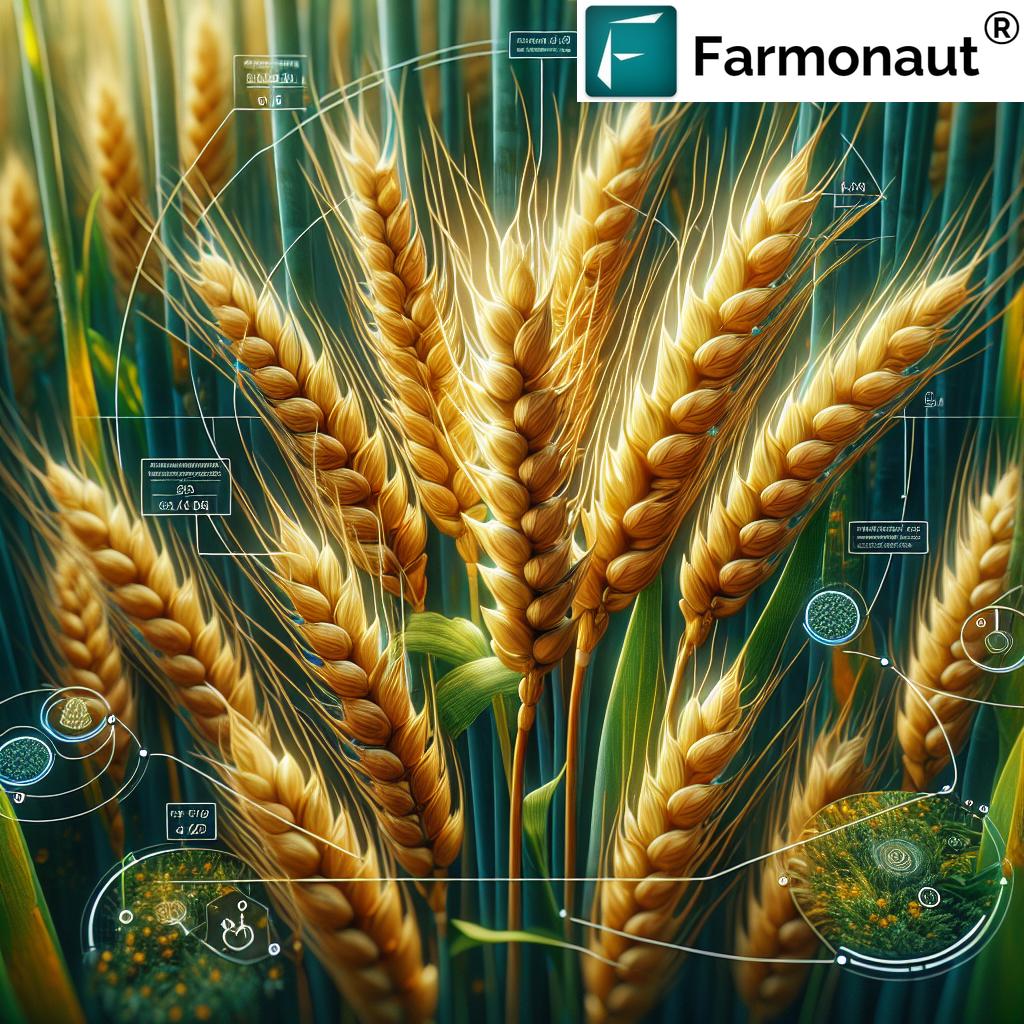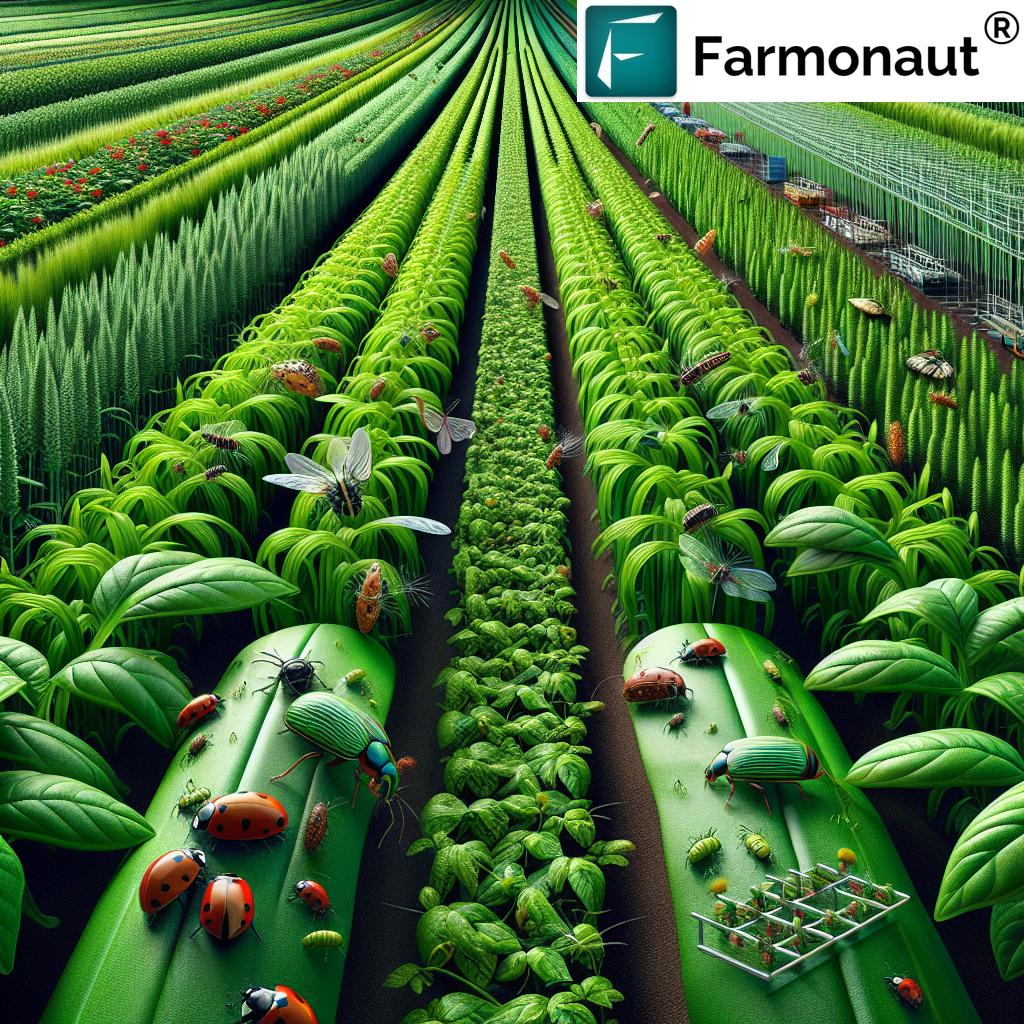Stages of Wheat Plant Growth: Complete Guide to Boost Yields
Meta Description: Explore the wheat growth stages from germination to ripening, and learn top management practices to optimize yield and grain quality in your wheat crop.
“Wheat plants pass through 8 distinct growth stages, each crucial for maximizing yield and grain quality.”
Why Understanding Wheat Growth Stages Matters
Wheat is a staple food crop, forming a significant part of the global agriculture landscape and providing sustenance to billions. The wheat growth stages define the development timeline of the wheat plant, directly influencing both the final yield and grain quality.
- Optimized crop management: Knowing the growth stage allows for precise timing of field operations, fertilization, and irrigation, maximizing wheat yield and protecting grain quality.
- Pest and disease control: The most effective interventions depend on recognizing the correct wheat growth stage.
- Input efficiency: Apply water, nitrogen, and phosphorus at exactly the right phase for uptake and plant health.
- Minimize stress: Identify and manage heat, drought, or nutrient limitations before they cause irreversible damage during crucial growth phases.
Let’s dive into the complete guide for each wheat plant development stage and unlock the secrets to maximizing yield and grain quality.
An Introduction to Wheat Plant Development
From the moment wheat seeds are sown, a complex and fascinating biological process unfolds. This journey from germination to final grain harvest is segmented into clearly defined growth phases. Understanding this cycle is key for employing wheat cultivation practices that directly impact the crop’s ultimate success.
Modern research and technologies—especially precision monitoring—now allow us to monitor wheat crop health at every stage, detect potential risk factors, and intervene with targeted actions. Managing nitrogen, water, and other resources precisely can be the difference between an average harvest and a record-breaking one.
Let’s break down the wheat growth stages into manageable milestones with the timeline table below for a practical overview.
Wheat Growth Stages Timeline and Key Practices
| Growth Stage | Estimated Days After Sowing | Visual Characteristics | Recommended Management Practices | Expected Impact on Yield/Quality |
|---|---|---|---|---|
| Germination & Seedling | 0-7 | Seed swells, shoots appear, first leaves emerge |
|
Foundation for healthy crop establishment |
| Tillering | 7-30 | Additional shoots (tillers) from base of main stem, 3-4 leaves |
|
Maximizes potential grain-bearing heads, determines plant population |
| Stem Elongation | 30-45 | Internodes lengthen, stem height increases, visible nodes |
|
Supports eventual head development |
| Booting | 45-55 | Head (spike) enclosed in flag leaf sheath, swelling visible at top of stem |
|
Prepares plant for successful heading and flowering |
| Heading | 55-60 | Head emerges from boot, spike fully visible |
|
Directly impacts grain potential |
| Flowering (Anthesis) | 60-65 | Florets open, anthers visible, brief flowering (4-5 days) |
|
Determines seed set and quality |
| Grain Filling | 65-90 | Kernels accumulate starch/protein, heads begin to droop |
|
Critical for kernel weight and grain quality |
| Ripening | 90-120 | Grains lose moisture, harden, yellow-brown stems |
|
Final phase for optimal grain harvest |
“Optimal wheat germination occurs at soil temperatures between 12°C and 25°C, ensuring strong early crop establishment.”
1. Germination and Seedling Stage: Foundation of Wheat Crop Success
Germination is the starting point for every wheat crop’s growth journey. This vital stage begins immediately after sowing, as wheat seeds absorb water, swell, and sprout their first seedling.
Key Processes & Optimal Conditions for Wheat Germination
- Temperature range: 10°C–30°C (50°F–86°F). Optimal: 12°C–25°C for uniform and rapid emergence.
- Moisture: The soil must be moist (but not waterlogged) to trigger enzymatic activity in the wheat seed for germination.
- Soil conditions: Well-aerated soils with good seed-to-soil contact are ideal.
- Emergence: Under favorable conditions, the wheat seedling emerges within ~7 days after sowing.
Visual Indicators
The first visible leaf (cotyledon) breaks through the soil surface, establishing photosynthesis and initiating independent energy production.
Why Germination Matters for Yield
- Uniform and strong seedling emergence sets the stage for optimal tillering and plant vigor.
- Poor germination can cause patchy stands, reducing potential grain heads and yield.
Best Practices for Management
- Use high-quality seeds and maintain correct seeding depth.
- Ensure soil moisture at sowing and avoid compacted soils.
According to howtogroweverything.com, prompt emergence ensures wheat seedlings utilize stored nutrients before the first leaf becomes fully functional.
2. Tillering: Boosting Potential Grain Yield
Following successful seedling establishment, wheat plants transition into the tillering stage. This phase is characterized by the emergence of additional shoots (tillers) from the plant’s base—every tiller has the potential to produce a grain-bearing head.
What Drives Tillering?
- Temperature: Optimal range: 15°C–20°C (59°F–68°F).
- Nutrients: Nitrogen and phosphorus are essential—adequate supply supports healthy tiller development.
- Light: Shorter days with cool temperatures often increase tiller numbers.
- Water: Consistent moisture is crucial.
Visual Characteristics
- Plants typically have 3–4 leaves before tillers emerge.
- Secondary shoots become visible at the base, spreading outwards.
Why Tillering is Critical for Wheat Yield
- The number of productive tillers directly correlates with the final number of wheat heads and thus, overall yield.
- Stress, nutrient deficiencies, or drought can reduce tiller count and grain potential.
Management Tips
- Monitor nutrient levels using soil tests—apply N and P if needed.
- Farmonaut can help monitor vigor and tiller uniformity using satellite data for early intervention if patches of low growth or yellowing are detected.
- Control weeds promptly as they compete for water and nutrients.
3. Stem Elongation: Moving Wheat Into High Growth
During stem elongation, the wheat plant undergoes rapid height increase, and critical internal changes set the stage for the developing head to reach its final form.
Key Processes
- Wheat stems elongate as internodes (stem segments between leaf nodes) lengthen.
- The developing wheat head begins to move upward, still encased within the stem’s sheath.
- Visible increase in crop height and appearance of nodes upon splitting the stem.
Management Practices
- Water demand increases—ensure irrigation keeps up with rapid vegetative growth.
- Monitor nitrogen status—this is a critical period for N uptake to support high biomass and eventual grain development.
- Identify and correct nutrient deficiencies; scout for diseases (rust, leaf spots).
- Use of advanced crop monitoring tools, like those in the Farmonaut Platform, can detect zones of poor vigor from space and pinpoint exactly where attention is needed.
Impact on Yield
- This stage builds the “framework” for wheat head size and grain-filling ability.
- Stress (drought, nutrient deficiency) at this point can cause irreversible drops in potential yield.
4. Booting and Heading: Preparation for Grain Set
As wheat transitions from vegetative growth to reproductive development, two key stages—booting and heading—signal the crop’s readiness to form grains.
Booting Stage
- The uppermost leaf (flag leaf) appears, and the developing head becomes enclosed within the leaf sheath, causing a visible “swelling” or “boot.”
- Typically 6–8 weeks after crop emergence.
Key Management: Avoid stress (heat, drought, or physical damage) that can impair pollen formation inside the boot.
Heading Stage
- The wheat head emerges from the boot, becoming visible for pollination.
- Grain number for the crop is predominantly determined at this stage.
- The plant becomes more susceptible to environmental stresses—high temperature, drought, wind or hail can all affect grain formation.
Satellite-based monitoring tools provided by Farmonaut enable us to detect heading progress and track crop uniformity remotely—invaluable for making field-wide decisions fast.
Management Practices
- Maintain sufficient moisture during booting and through heading.
- Apply foliar protectants or growth regulators if recommended.
5. Flowering (Anthesis): Securing Your Grain Set
Flowering or anthesis is a short yet critical stage in wheat plant development. This is when pollination and fertilization occur, ultimately locking in the final grain number and quality.
Key Features
- Open florets become visible on the wheat head, anthers extrude and pollination takes place—usually over 4–5 days.
- Temperature range for optimal pollination: 18°C–24°C (64°F–75°F).
- Wheat is primarily self-pollinated, but stresses (excessive heat, drought, frost) can drastically reduce seed set.
According to sanangelo.tamu.edu, most wheat florets are pollinated even before the anthers become visible, yet environmental stress can still diminish the number of fertile florets.
Best Practices for Maximizing Pollination Success
- Avoid any plant stress during anthesis (water, heat, and pest control are especially important).
- Do not apply herbicides at this stage; consult local guidelines before fungicide use.
Tip: Advanced crop health monitoring from Farmonaut can send real-time alerts for weather risks and help identify zones where irrigation or rapid intervention could preserve grain set.
6. Grain Filling and Ripening in Wheat: Finalizing Yield and Quality
After flowering, the wheat plant focuses all its resources on grain filling, followed by ripening. This final stage of development is crucial—deciding grain size, weight, and quality.
Grain Filling
- Kernels accumulate starch and proteins, expanding and gaining weight.
- Heads begin to “nod” as they fill and gain mass, and green color starts to fade.
- Lasts 20–30 days, depending heavily on temperature and water availability.
Ripening Phase
- Grains lose moisture, harden, and yellow-brown stems—reaching physiological maturity.
- Moisture content drops from ~80% to 20-25% by harvest.
Best Management Practices
- Irrigate if possible during early filling, but reduce watering as crop ripens to avoid preharvest sprouting or disease.
- Monitor for late-season diseases or pests—preserve healthy leaves for maximum grain fill.
- Use satellite and yield predictions from Farmonaut for harvest planning over large areas.
Impact of Temperature and Drought
- Hot and dry conditions speed up ripening but can reduce grain size (and overall yield).
- Prolonged grain fill (with adequate moisture) increases both yield and test weight.
Understanding the Feekes Scale: A Standard for Wheat Growth Stage Identification
The Feekes scale is a globally recognized system for describing wheat growth stages using a simple numerical scale from 1 (emergence) to 11.4 (mature grain). Developed in the Netherlands in 1941, Feekes scale wheat references are widely used in U.S., Europe, and major wheat-producing regions.
How is Feekes Scale Wheat Useful?
- Ensures precise timing for fertilizer, pesticide, and fungicide applications.
- Reduces risk of applying inputs during sensitive stages (such as flowering or grain filling).
- Improves field scouting—know which symptoms or issues are most likely at each growth point.
For a full breakdown of Feekes and other cereal growth scales, visit the Wikipedia reference on cereal growth staging.
Key Wheat Cultivation Practices & Management Tips for Each Stage
- Germination & Seedling: Seed into moisture, at optimal depth, and in fields free of compaction or crusting.
- Tillering: Ensure a sound nitrogen and phosphorus plan; scout for weeds or young aphids.
- Stem Elongation: Adjust irrigation to meet increased water needs, check for symptoms of nutrient or disease stress.
- Booting & Heading: Keep the soil moist, protect from fungal diseases, avoid physical disturbance, and ensure gentle handling of the crop.
- Flowering: Withhold herbicides unless absolutely necessary, provide cooling irrigation during hot spells if available.
- Grain Filling & Ripening: Stop fertilizing, schedule irrigation cuts carefully, watch for fungal problems, and start harvest when grain moisture is optimal (20–25%).
For detailed, site-specific advice—including interpreting satellite health indices (NDVI, NDWI, etc)—consider using the Farmonaut Jeevn AI Advisory System. Our AI-based guidance delivers real-time, actionable management strategies right to your phone or browser.
Farmonaut: Precision Tools to Optimize Wheat Crop Management
At Farmonaut, we offer advanced satellite-based crop health monitoring that helps farmers and agribusinesses track every phase of wheat plant development. Through our Android, iOS, and web apps, you get access to:
- Real-time crop health insights: Identify nutrient deficiency, water stress, or pest issues long before visual symptoms appear—informed by NDVI and satellite-derived indices.
- Soil moisture tracking: See water availability by field zone, enabling more precise irrigation at critical stages.
- AI-driven advice: Our Jeevn AI Advisory System gives customized action plans for nitrogen, phosphorus, and water application, based on growth stage and detected stress.
- Blockchain traceability: Transparently document every stage of wheat production, beneficial for compliance and consumer trust. Explore our blockchain-based product traceability solution.
- Fleet Management: For large-scale operations, our platform supports fleet/equipment management—optimizing machinery use across sprawling wheat fields.
- Carbon Footprinting: Document your environmental impact and discover opportunities for more sustainable wheat cultivation with our carbon tracking module.
- API Access: Seamlessly integrate satellite and weather data into your farm’s existing management system—with our robust API and developer documentation here.
- Crop Loans & Insurance: Speed up bank verification and insurance processing with our satellite-verified crop loan and insurance support.
Farmonaut is dedicated to making precision agriculture affordable and accessible worldwide. Whether you’re managing a smallholding or vast farms in wheat-growing regions, our platform scales to your needs.

Explore our full wheat monitoring platform here.
Ready to amplify your wheat harvest? Download the Android or iOS app for on-the-go, actionable wheat growth advice!
FAQ: Stages of Wheat Plant Growth
Q1. Why are wheat growth stages important for yield and management?
Each wheat growth stage—from germination to ripening—affects critical factors like tiller number, head development, grain set, and filling. Properly timing inputs and stress management at each stage maximizes total yield and grain quality.
Q2. How do temperature and water availability influence wheat plant development?
Temperature and moisture fundamentally drive plant development rates, tiller survival, flowering success, and grain filling. Optimal temperature and irrigation timing help avoid heat or drought stress during sensitive phases (e.g., anthesis, grain fill), preserving final yield.
Q3. What is the best way to monitor wheat crop health across large fields?
Satellite-based tools—such as those offered by Farmonaut—allow for real-time, zonal insight into crop vigor, moisture, and stress across hundreds of hectares quickly, minimizing losses and optimizing management at exactly the right time.
Q4. What specific wheat cultivation practices improve the number of productive tillers?
Early-season nitrogen and phosphorus application, maintaining optimal soil moisture, and controlling weeds/pests during tillering significantly boost healthy tiller production, directly raising potential yield.
Q5. How do I time my wheat harvest for the best quality?
Ideal wheat harvest begins when grain moisture is ~20–25%, the grain is hard, and stems turn yellow-brown. Delaying harvest beyond this can increase losses from shattering, sprouting, or disease.
Conclusion: Rise with Data-Driven Wheat Farming
Wheat cultivation remains the backbone of global agriculture, feeding populations and delivering value across food, feed, and industry. Understanding wheat growth stages—from germination to ripening—and applying the latest precision management strategies at each step is the most reliable way to maximize yield and grain quality in every field.
- Track each development phase and time actions for nutrient, pesticide, and water applications.
- Respond to crop stress instantly using real-time monitoring and smart alerts.
- Adopt advanced Farmonaut solutions for sustainable, profitable, and future-ready wheat production.
Whether you farm a few acres or thousands of hectares, the core principles remain the same—knowledge, vigilance, and timely action are your most powerful yields boosters!










